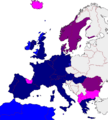Article (grammar) facts for kids
An article is a word that comes before a noun. There are two kinds of articles: definite articles and indefinite articles.
In English there is just one definite article: "the". There are two indefinite articles: "a" and "an". The word "an" is used before a word starting with a vowel sound (not necessarily a vowel letter): we say "a horse", "a child", "a European" (European has a "Y" sound, /j/, which is a consonant sound), "a university", but "an orange", "an elephant".
Some languages have more than one word for "the". In some languages, this is because each noun is either masculine or feminine or, in some languages it can be masculine, feminine or neuter. For example: in French "le" is used for masculine nouns ("le jardin" - "the garden") and "la" for feminine nouns ("la table" - "the table"). "The" becomes "les" in front of plural nouns. The indefinite articles in French are "un" (masculine) and "une" (feminine). German, Dutch and Ancient Greek have masculine, feminine and neuter nouns, but in the case of Dutch the word for "the" is the same for masculine and feminine ("de") so you do not need to know which it is. The Māori language uses one word for "the" for when the subject or object to which the "the" refers is one in number, and uses another word for "the" when the subject or object to which the "the" refers numbers more than one.
There are also many languages that do not have articles. Some examples include Russian, Hindi, Japanese, and Chinese. When speakers of these languages are learning English, it is often difficult to explain to them what an article is because English speakers use them naturally. Even though these languages do not have articles, they still have grammatical features that allow them to show definiteness.
In general: "the" in English is used for something you already know about or have already been talking about. The word "a" is used when introducing a new idea:
"The tired woman was looking for her cat. Suddenly she saw the cat up a tree". (We are already talking about the cat. The tree is a new idea).
"The tired woman was walking along when she suddenly saw a cat up a tree". (She had not been thinking about cats until then).
Sometimes we do not need an article, for example when talking about something in general:
"The dogs do not bite" (meaning: dogs that you are thinking about). "Barking dogs do not bite" (barking dogs in general).
Images for kids
-
Articles in languages in and around Europe indefinite and definite articles only definite articles indefinite and suffixed definite articles only suffixed definite articles no articles Note that although the Saami languages spoken in northern parts of Norway and Sweden lack articles, Norwegian and Swedish are the majority languages in this area. Although the Irish, Scottish Gaelic and Welsh languages lack indefinite articles they too are minority languages in Ireland, Scotland and southern Wales, respectively, with English being the main spoken language.
See also
 In Spanish: Artículo (gramática) para niños
In Spanish: Artículo (gramática) para niños


